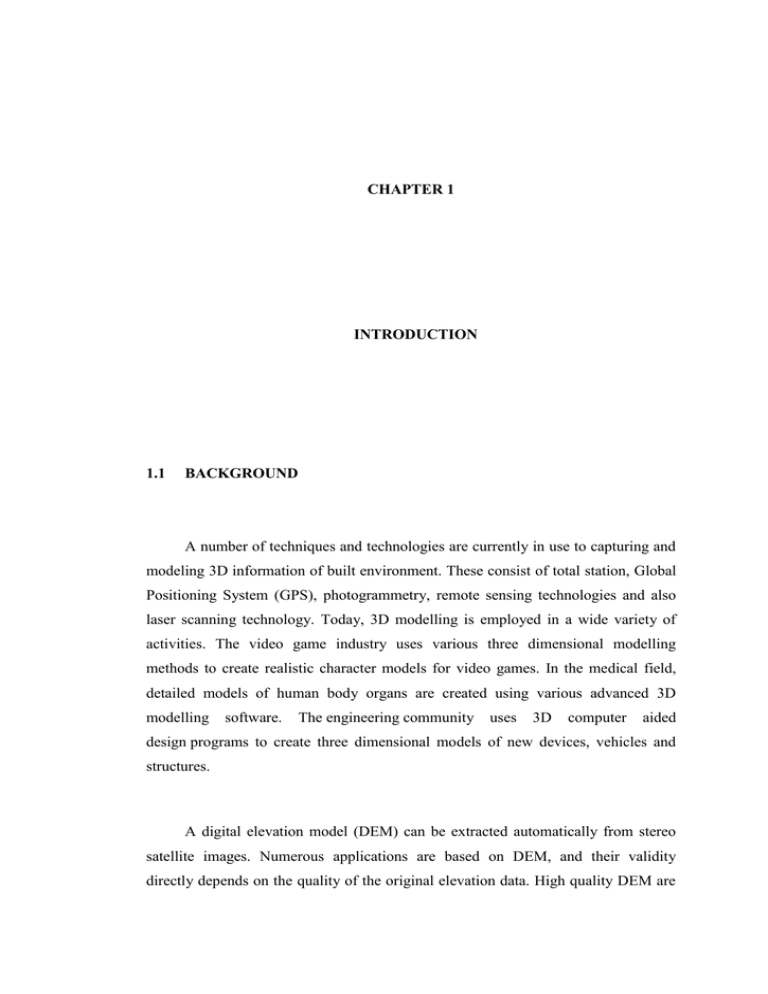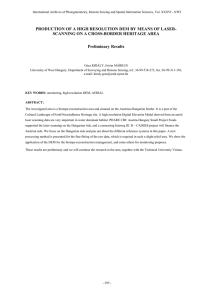CHAPTER 1 INTRODUCTION 1.1 BACKGROUND
advertisement

CHAPTER 1 INTRODUCTION 1.1 BACKGROUND A number of techniques and technologies are currently in use to capturing and modeling 3D information of built environment. These consist of total station, Global Positioning System (GPS), photogrammetry, remote sensing technologies and also laser scanning technology. Today, 3D modelling is employed in a wide variety of activities. The video game industry uses various three dimensional modelling methods to create realistic character models for video games. In the medical field, detailed models of human body organs are created using various advanced 3D modelling software. The engineering community uses 3D computer aided design programs to create three dimensional models of new devices, vehicles and structures. A digital elevation model (DEM) can be extracted automatically from stereo satellite images. Numerous applications are based on DEM, and their validity directly depends on the quality of the original elevation data. High quality DEM are 2 seldom available, and photogrammetric is the most common technique to produce DEM for decades. Dependence on analogue aerial images ended formally in 1980, when the American Society of Photogrammetry and Remote Sensing (ASPRS) included the possibility of using digital data from remote sensing in its definition of photogrammetry (Slama, 1980). The quality of Digital Elevation Models (DEMs) elaborated from stereoscopic pairs is affected by the topography of the terrain and the data source (aerial photographs or digital satellite images), as well as other variables that depend on the data (aerial or spatial), on the algorithms used in the photogrammetric workstations, and on the data structure such as the triangulated irregular networks (TIN) versus uniform regular grids. Digital photogrammetric techniques have been known for decades, but the possibility of using stereoscopic images from satellites for global digital elevation data production did not arised until the launch of the SPOT series in 1986. Today several satellites also offer the possibility for stereoscopic acquisition: SPOT, MOMS, IRS, KOMSAT, AVNIR (Hashimoto, 2000), TERRA and more recently, the high resolution push broom scanners IKONOS (September 1999), EROS-A1 (December 2000), QUICKBIRD-2 (October 2001), SPOT 5 (May 2002), and ORBVIEW-3 (June 2003). Thus, some studies focus on constructing DEM from stereoscopic images by means of high resolution push broom scanners, IKONOS (Toutin et al., 2001), EROS A1, SPOT 5 (Petrie, 2001); furthermore, it is assumed that the automatic generation of a DEM from remotely sensed data with a Z sub pixel accuracy is possible. The accuracy of DEM elaborated from aerial stereoscopic pairs has been exhaustively analyzed but not all knowledge can be accepted in the spatial images case without a detailed analysis. Several factors distinguish both cases, e.g. the image spatial resolution, and the timing and geometric design of acquisition. These factors cause some common problems when using stereoscopic spatial images, e.g., the 3 difficulty of identifying the ground control points (GCP), or the existence of radiometric differences among the images due to acquisition at different dates that may make the stereo-matching process more difficult. Accuracy estimation can be carried out by comparing the DEM data with a set of check points measured by high precision methods. The basic conditions for a correct work flow are: a) high accuracy of check points, and b) enough points to guarantee error control reliability. Deriving DEM from stereoscopic satellite images is not new; however accuracy results and the method used to calculate error and reliability in DEM differ according to the literature revised. This variation may be due to the method used to estimate error in DEM by using the check points. DEM accuracy is estimated by a comparison with DEM Z values, and by contrasting many check points with “true” elevations. The pair wise comparisons allow the calculation of the Mean Error (ME), Root Mean Square Error (RMSE), Standard Deviation (SD) or similar statistics. It‟s obvious that reliability in the processes is not a constant but depends on several factors. The number of check points is an important factor in reliability because it conditions the range of stochastic variations on the standard deviation values. Another factor is obvious where the number of check points must be sufficient for the accuracy assessment. By using DEM and georefrencing satellite image, it is possible to generate 3D surface view of an area. This 3D view depends on the resolution of DEM and satellite image. If the resolution is good then 3D objects can be extracted from the view. 3D surface view is used to visualize elevation or other surface data in 3D. Users can use 3D surface view to display the surface data as a wire-frame, a ruled grid, or as points, to drape the surface data with a gray scale or colour image, and overlay it with region of interest and vectors and other things. 4 1.2 PROBLEM STATEMENT For decades almost every community or city around the globe has relied on 2D maps to represent their living environment. These maps have helped a lot in solving problems in variety of area. However, some problems such as performing analysis on flight and communications signals, landslide analysis, calculating cut and fill volumes in earth works, and finding height and volume of features were found impossible to be solved using 2D maps. Therefore, 3D model representation of places is very important for analysis and other findings that can only be done using 3D spatial representation. The matching problem and the mathematical model relating the scene and ground coordinates of corresponding points are the most difficult problems associated with DEM generation from high resolution imaging satellites. To ensure a reliable solution of the matching problem, prominent features, as represented by an interesting signal around the selected primitives are usually used. Problems arised when the geometric correction of satellite imagery in areas where suitable topographic maps are not available. GPS technology is increasingly seen as a potential solution in such areas. 1.3 THE AIM AND OBJECTIVES OF RESEARCH The aim of this project is to generate DEM based on ASTER satellite image. The specific objectives are: 1. To generate DEM using ENVI and PCI softwares and view the surface in 3D. 2. To determine the accuracy of the generated DEMs. 5 1.4 SIGNIFICANCE OF RESEARCH The significance of the research covers the benefit that will be potentially gained when this research is implemented. This project is limited to generation of DEM of Johor state environment. The document of this project can be used as resource for students and other researchers for further research and consultancy works. The DEM generated from satellite stereo pairs have some significant advantages over other sources: 1. World wide availability of satellite data without any restriction (often available as archived data) as against restricted and non availability of topographical maps and aerial photographs. 2. Large area coverage per scene. 3. Medium resolution. 4. Faster processing through sophisticated software and little manual effort. 5. Low processing cost. 6. All weather and day/night image acquisition capabilities (in case of microwave sensors). The primary point of DEM is to provide high quality 3D model for the purpose of 3D visualisation. Once a DEM model is constructed for an area of interest, user may use this to model fault traces, find the geometry of turbidity current deposits or validate existing models. Resolution of the DEM is determined by the images that it is constructed from. 6 1.5 RESEARCH SCOPE The research scope covers the limit of the research. In this research the limits are as follows. The research area covers the satellite image of south Malaysia and some part of Singapore (Figure 1.1). Stereo pair of satellite image is used in this research for generation of DEM using different remote sensing software. ASTER LEVEL 1A.hdf covering south of Malaysia and some part of Singapore, ASTER LEVEL 1A hdf.met and ground control points(GCPs) are used as input data in this project (the ASTER information is shown in Appendix A). The GCPs were established using GPS technology. Data processing is carried out using PCI Geomatica 9.1 and ENVI 4.5 software. The research is limited to generation of DEM in the form of 3D and the accuracy of DEM is determined. 7 Figure 1.1: ASTER Satellite Image (2002) 1.6 RESEARCH METHODOLOGY The process or procedure of how this research was implemented is explained in the research methodology. This research methodology covers the steps or processes that will undergo before achieving final results. These stages include: literature review, planning, implementation, analysis, conclusion and recommendation. Figure 1.2 shows a diagrammatic flowchart of the research methodology intended for this project. 8 START LITERATURE REVIW Georefrencing NCE IMPLEMENTATION ASTER image PCI ENVI Input stereo image pair GPS Selecting GCPs GDTS Input stereo image pair Selecting GCPs softwa Collecting Tie points Collecting Tie points Perform Bundle Adjustment Creating Epipolar images Image matching Creating Epipolar images Generating DEM Generating DEM Overlaying Overlaying in ENVI Develop 3D surface view Develop 3D surface view ANALYSIS Qualitative Quantitative CONCLUSION Figure 1.2: Flowchart of the research methodology 9 Literature review stage The literature review is to explore the 3D view and DEM generation methodology, and tools required by referring to internet, magazines, books, conference paper or journal paper. This provides foundation of knowledge in order to conduct a good research. The research problem is formulated at this stage. Furthermore, scope of the research is also defined in this stage. The references that served as guides for conducting this research were also gained from the literature review. Planning stage The planning stage is where preparation is done prior to research implementation. This stage involves the development of conceptual framework, selection of software as well as data sources for the research. Software practice, understanding for data processing and model development are also done at this stage. Implementation stage This stage involves activities done in order to attain the final expected output. The process includes: data input, processing and output. ASTER L1A.hdr, ASTER L1A.hdr.met and ground control points (GCPs) were used as input to ENVI and PCI softwares. The softwares used in this project include the following: 10 i. Geodetic Datum Transformation System (GDTS) version 4.01 The coordinate system obtained from GPS instrument is in Malaysian RSO and need to be converted to WGS 84. By using this software the conversion is carried out. ii. PCI Geomatica version 9.1 Ground control points collection and generation of tie points were performed at this stage. Subsequently, epipolar images are created and finally Digital Elevation Model (DEM) is generated. Then this DEM is exported to ENVI to develop 3D surface view. iii. ENVI version 4.5 Stereo bands selection and GCP/TP collection are performed in this softwar too. Then Epipolar images and DEM were generated. After that, 3D surface view is developed by overlaying DEM and georefrenced ASTER image. Result and analysis stage After the implementation stage, the final results are produced from which analysis is made for further decisions or conclusion as well as future work. 11 Conclusion and recommendation stage The final outcome of the entire process from this research is concluded from which necessary recommendations is made based on the outcome. 1.7 THESIS OUTLINE Chapter One: Introduces the research topic, the background of study, problem statement, the objective, significant of the study, scope and methodology adopted. Chapter Two: The literature review is to explore the DEM generation methodology and tools by referring to Internet, magazines, books and conference or journal papers. Chapter Three: The respective steps that were involved in the implementation of the study in order to produce the objective achieving results are discussed in this chapter. Chapter Four: This chapter discussed the results and analysis of this study from which necessary conclusion and recommendation will be made. The analysis is done right after each result is presented so as to get clear understanding of the picture behind the results of each achieved objective. Chapter Five: In this chapter, problem encountered were discussed and make some conclusions and recommendations for future study.





